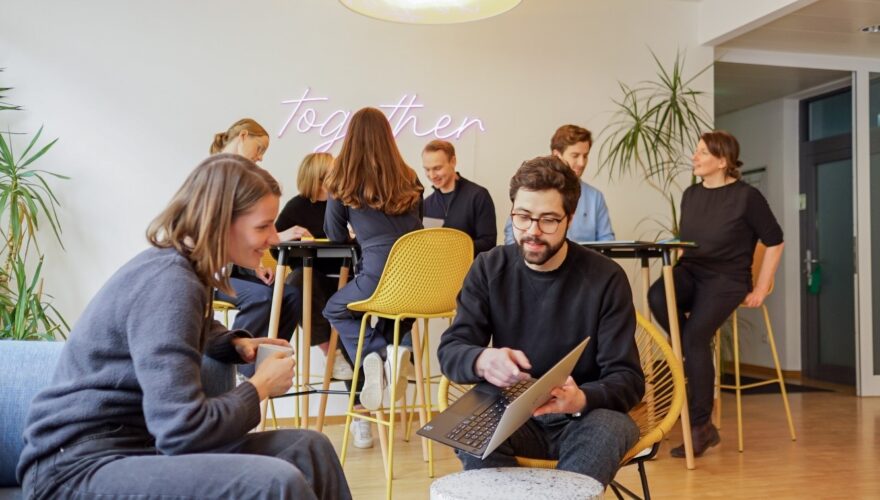Innovation is not an assembly line item
Multidisciplinarity is often neglected in the economy, in large organizations and also small enterprises. Specialist departments, expert committees, specialists work hermetically on new ideas and pass them on after fine-tuning. Within the team, there are people with the same or similar expertise and qualifications and comparable mindsets.
This creates a base of know-how, of course. But at the same time it prevents or paralyzes creative iterations, a culture of beneficial rejection and new creation and the inclusion of different perspectives. A problem when you consider that innovation is not an assembly line article.
For this reason, organizations are often forced to hire external service providers who ensure multidisciplinarity or bring it with them. The advantages are obvious: an increase in quality, creativity, networking and flexibility. It is particularly profitable for innovation projects if there is a heterogeneity of both the internal and the consulting teams. When they really bring diverse skills and competences, qualifications and mindsets to the table. Homogeneous teams often work together more smoothly, but an idea viewed and discussed from different perspectives will ultimately be much more sustainable than a one-dimensional one.
Our most recent project with Allianz confirms this. Our clients came from marketing, engineering and market teams in Europe, Turkey and the USA. We have enriched their invaluable skills with HYVE researchers, HYVE crowd strategists, HYVE industrial designers, end users and industry experts from the HYVE network. Together we have identified the fire safety needs of SMEs in various markets, conducted an idea competition with students and engineers on our HYVE Crowd and started to develop and prototype a fire safety solution with innovative technologies. There are five key roles that every innovation team should have.
5 roles that cannot be without each other for successful innovation
1. The market expert

It is the task of the market expert to have a clear understanding of the customer and his target group(s). He leads an explorative research phase at the beginning of the project in order to uncover needs. Researchers also test the prototypes. The results are sharpened in further rounds of prototyping and refinement of concepts until the physical result is ready for series production or until the new start-up is ready to be founded (the “measure” in the lean startup approach”build, measure, learn”). Finally, market researchers collect feedback from the target group about the company’s go-to-market strategy before the end product or service is on the shelves.
2. The crowd

… to initiate idea contests. Developing ideas does not only happen with stakeholders. External input from specialists or users is invaluable in two respects: additional perspectives produce radically new ideas, and work is outsourced to the crowd when stakeholders themselves do not have the resources to fully engage in the idea phase. The winning ideas of a crowd contest can be used for prototyping.
3. The Ideator

Ideators conduct ideation workshops with stakeholders, experts and lead users to jointly create physical and digital concepts. Their role is critical in fostering creativity in stakeholder teams, but also to ensuring that ideas are feasible by developing a proof of concept or facilitating discussions with the client’s technical experts. In short, they turn a difficult process into a smooth and enriching experience.
4. The Designer

Designers create prototypes, from sketches to 3D models, from wireframes to clickable dummies and interactive screens. They bring in their physical or digital know-how, but also speed up the prototyping process. They visualize concepts that help our customers sell their ideas internally. They design, create, 3D-print, encode, build first prototypes of the concept, so that users can try them and give feedback. They further develop the innovation in order to prepare it in the factory (if it is a product) or hand over the design for the development of digital services (if it is a digital service).
5. The strategist

Mostly on the customer’s side, the strategist knows the business from the ground up and ensures that the new product or service is profitable, i.e. creates value for the company. The strategist aligns all innovation efforts with the corporate strategy, internalizes the process within the company, brings in the decision makers and contributes to the design of a new business model if required.
The 5-role logic was successfully applied together with our client MAM Babyartikel. In a conversation with the project manager it became clear that for MAM the multidisciplinarity on the part of HYVE was decisive for the success of the project. The many possibilities such as project management, method consulting, design performance, software support and market research combined under one roof led to maximum flexibility and a fast result. You can be curious!
You want to learn more about HYVE's multidisciplinarity?


